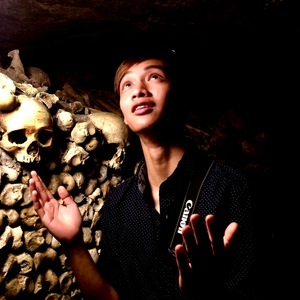A meal without a drink is like a failed marriage; dull, unsatisfactory, and it leads to a dry throat – water on the other hand is like a stale and bland infatuation. A meal with wine, however, is an intense, passionate affair.
My inner sommelier, a personality I hate and will always associate as a rather gaudy and brash pursuit to be refined, would say that the integration of alcohol, acidity, and the creative expressiveness of the grapes, highlight the sometimes sweet, sometimes bitter and fruitful connectedness that ultimately brings people – who share a common culture and the appreciation of a finer lifestyle – together.
The Wine Tasting

Even though I’ve brutally murdered and buried my rather snobby and pretentious old self in the pits of my youth, the thought of trying too hard to impress others by being refined and sophisticated still haunts me. What was it that made me pursue such a dull-witted manner of thinking? Delusions of grandeur perhaps? Nevertheless, I remained curious by how wine continues to influence our history, cuisine, and culture.
The fact that I’m 18 conflicts with both my curiosity and the legality of the situation I’m in. No, I don’t have a fake ID, and I have no intention of getting one… not that I know where to get one, because I don’t. So where does this impetus and drive to satisfy my eagerness with wine come from? I’m not an alcoholic, nor am I much of a foodie. I’m just inherently curious.
Growing up in the Philippines, in a large and highly liberal family, I was able to have the occasional “taste” or “sip” of alcohol. My grandmothers were against it though, they said that drinking was a “sin” and that I would go to hell for it—imagine saying that to an eight-year-old who was born a Roman Catholic, but raised as a Protestant.

Nevertheless, combined with my youthful angst, fake confidence, and peer pressure from my drunken uncles who reeked of beer, the rush of doing something bad felt so good. I realized something back in my home country. I hate the taste of beer. It’s bitter, foamy, urine-colored, and carbonated. That, coupled with the fact that I am now somewhat Agnostic, I asked myself, what kind of God would send me to hell for being curious?
Then I realized that his son, Jesus, could turn water into wine, and everybody loved him!

My very first wine tasting was in Bordeaux, where my eyes, tongue, and all the other sensations were greatly astounded. With my family, we escaped the Parisian streets, succumbed by avid smokers, Chinese tourists, and its fruitful history, and took the train to Bordeaux to a private tour at Chateau Lynch – Bages and Chateau Leoville Poyferre.
I was 17 at that time and was given the opportunity to drink with adult supervision (a more civilized version of my drunken uncles). Surrounded by the lush green countryside and the weathered tile homes, our tour guide showed us the vast fields of grapevines, the overwhelming amount of barrels stacked up together, and the metallic distilleries that towered the chateau. All of it was just jaw dropping to the eyes of my formerly pretentious self.

Our tour guide then led us to the tasting room, it was in a small room equipped with a silver spit bucket, multiple temperate bottles, and glasses of different sizes. In Chateau Lynch – Bages, our tour guide opened a bottle of Pauillac, a red wine, which was a blend of Merlot, and other things I can’t remember.
He popped the cork, took a sniff, and left the wine to breathe while he described how the wine came to be. He poured an innocent and minuscule amount for me, while a more generous amount for my family. I drank the wine quickly, like a shot (hoping that I could get seconds) and our tour guide looked at me as if I just killed a man.
My Takeaways

Our tour guide then took a pause, and described the wine. And he described it in a way with such finesse and expertise that I felt engulfed, bewildered, and impressed at the same time. Of course my old pretentious self would copy him. In Chateau Leoville Poyferre, our tour guide opened a red as well — a 2012 bottle with the same appellation and a blend like the Pauillac. The difference between the two wines is that the Pauillac was “oaky” and had “a hint of spice,” and the 2012 was “intense and young”.
Looking back, I can see why I lost interest in the whole wine tasting game. They all tasted the same to me! I couldn’t tell what ”oaky and a hint of spice” tasted like or what “intense” really meant. I could distinguish the difference between Chardonnay and Cabernet Sauvignon because one is white and the other is red, but that’s just one of many observations one can make with wine. I wanted to be well versed and classy like our guide — it turns out that I was just fooling myself.
In spite of this, the art of indulging oneself with wine or alcohol is a passage. A ritual that defines a situation, be it a celebration or mourning. It conveys and shares a message of emotions and consequences; it defines a culture – a toast of honor that could be interpreted in different ways. It could be refined and delicate, and it could also be complex, coarse, with a hint of pretentiousness.


